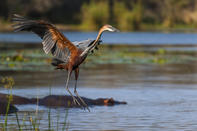
Name
Goliath heron (Ardea goliath)Goliath Heron Appearance
Standing at 1.43 m and with a wingspan of around 2 m, the Goliath heron is the world’s largest heron. The Goliath heron has slate-grey plumage, with a rusty or chestnut coloured head and a streaky neck. The chin and throat are white. The Goliath heron has black legs and a yellow eye, with a yellow eye ring.Both sexes are similar.
Goliath Heron Diet
The Goliath heron feeds primarily on fish and is able to catch and eat fairly large fish. This heron will also feed on frogs, small mammals and reptiles. The prey is swallowed whole. With large fish, the Goliath heron will stab the fish in the gill area with its beak, then when the fish is stunned, it will carry it to the bank to eat. The Goliath heron is often subject to kleptoparasitism, they regularly have their catch stolen by fish eagles.Goliath Heron Breeding
The Goliath heron normally breeds solitary, but they do occasionally breed in a mixed heron colony. The couple builds a large nest of sticks that can be built in a tree, in reedbeds, or on the ground on an island.
The nest is built very close to water. The female lays 2 to 3 eggs and incubation lasts around 4 weeks. The incubation and feeding of the chicks are shared by both parents. The chicks fledge at around 6 weeks after hatching.
Goliath Heron Behaviour
The Goliath heron is normally solitary and is able to hunt in deeper water. When walking, it moves through the water very slowly. When hunting they will stand motionless with a tall posture. It can remain motionless for up to an hour.The Goliath heron has a slow and steady wing beat when flying. The legs are held at an angle below the body, not horizontally like other herons.
Goliath Heron Threats
Listed as least concern. Competition outside of protected areas, from overfishing, is becoming a threat for this heron.Goliath Heron Distribution and Habitat
The Goliath heron is widespread, but generally not a common resident in its range. It is found mostly along the shallow edges of water bodies.The Goliath heron is found throughout South Africa, except in arid regions.